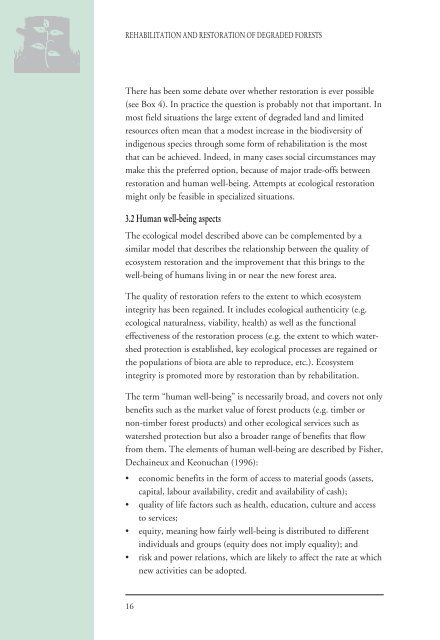Rehabilitation and Restoration Of Degraded Forests (PDF) - IUCN
Rehabilitation and Restoration Of Degraded Forests (PDF) - IUCN
Rehabilitation and Restoration Of Degraded Forests (PDF) - IUCN
Create successful ePaper yourself
Turn your PDF publications into a flip-book with our unique Google optimized e-Paper software.
REHABILITATION AND RESTORATION OF DEGRADED FORESTS<br />
There has been some debate over whether restoration is ever possible<br />
(see Box 4). In practice the question is probably not that important. In<br />
most field situations the large extent of degraded l<strong>and</strong> <strong>and</strong> limited<br />
resources often mean that a modest increase in the biodiversity of<br />
indigenous species through some form of rehabilitation is the most<br />
that can be achieved. Indeed, in many cases social circumstances may<br />
make this the preferred option, because of major trade-offs between<br />
restoration <strong>and</strong> human well-being. Attempts at ecological restoration<br />
might only be feasible in specialized situations.<br />
3.2 Human well-being aspects<br />
The ecological model described above can be complemented by a<br />
similar model that describes the relationship between the quality of<br />
ecosystem restoration <strong>and</strong> the improvement that this brings to the<br />
well-being of humans living in or near the new forest area.<br />
The quality of restoration refers to the extent to which ecosystem<br />
integrity has been regained. It includes ecological authenticity (e.g.<br />
ecological naturalness, viability, health) as well as the functional<br />
effectiveness of the restoration process (e.g. the extent to which watershed<br />
protection is established, key ecological processes are regained or<br />
the populations of biota are able to reproduce, etc.). Ecosystem<br />
integrity is promoted more by restoration than by rehabilitation.<br />
The term “human well-being” is necessarily broad, <strong>and</strong> covers not only<br />
benefits such as the market value of forest products (e.g. timber or<br />
non-timber forest products) <strong>and</strong> other ecological services such as<br />
watershed protection but also a broader range of benefits that flow<br />
from them. The elements of human well-being are described by Fisher,<br />
Dechaineux <strong>and</strong> Keonuchan (1996):<br />
• economic benefits in the form of access to material goods (assets,<br />
capital, labour availability, credit <strong>and</strong> availability of cash);<br />
• quality of life factors such as health, education, culture <strong>and</strong> access<br />
to services;<br />
• equity, meaning how fairly well-being is distributed to different<br />
individuals <strong>and</strong> groups (equity does not imply equality); <strong>and</strong><br />
• risk <strong>and</strong> power relations, which are likely to affect the rate at which<br />
new activities can be adopted.<br />
16

















